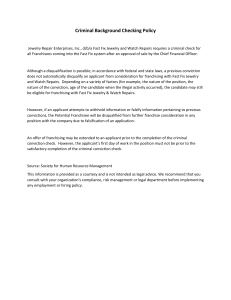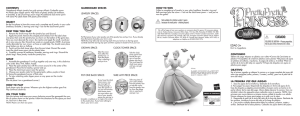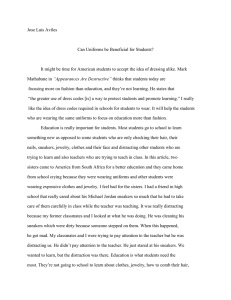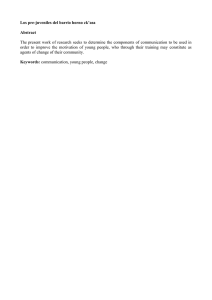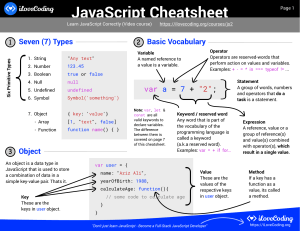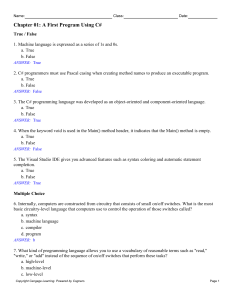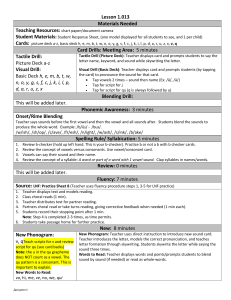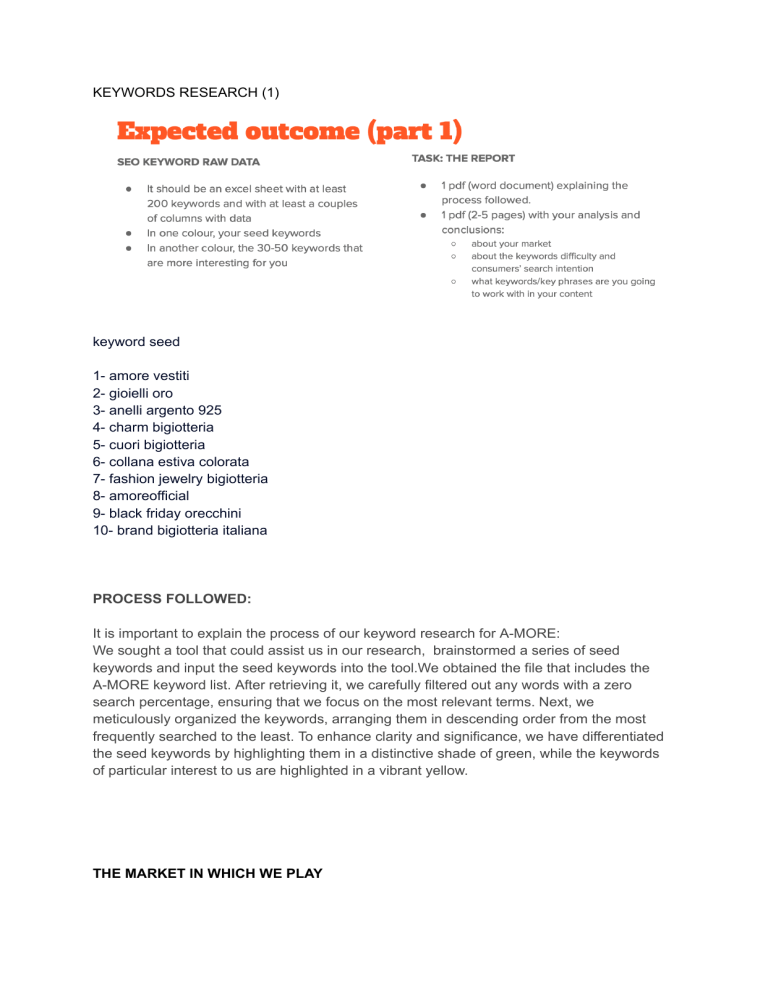
KEYWORDS RESEARCH (1) keyword seed 1- amore vestiti 2- gioielli oro 3- anelli argento 925 4- charm bigiotteria 5- cuori bigiotteria 6- collana estiva colorata 7- fashion jewelry bigiotteria 8- amoreofficial 9- black friday orecchini 10- brand bigiotteria italiana PROCESS FOLLOWED: It is important to explain the process of our keyword research for A-MORE: We sought a tool that could assist us in our research, brainstormed a series of seed keywords and input the seed keywords into the tool.We obtained the file that includes the A-MORE keyword list. After retrieving it, we carefully filtered out any words with a zero search percentage, ensuring that we focus on the most relevant terms. Next, we meticulously organized the keywords, arranging them in descending order from the most frequently searched to the least. To enhance clarity and significance, we have differentiated the seed keywords by highlighting them in a distinctive shade of green, while the keywords of particular interest to us are highlighted in a vibrant yellow. THE MARKET IN WHICH WE PLAY Humans have worn jewelry for many thousands of years. It is one of the most ancient and enduring forms of personal expression. Whether it’s a luxurious diamond necklace, or a simple charm bracelet, jewelry can make the wearer instantly feel more confident and stylish. In 2022, the global luxury jewelry market amounted to about 28 billion euros. Globally, the lion’s share of the jewelry and watch market revenue generated in 2022 is attributed to three countries: China was the largest, followed closely by India and the United States. The value of the jewelry market is expected to increase from about 270 billion U.S. dollars in 2022 to over 330 billion dollars by 2026. One of the most exciting new innovations in the jewelry industry is lab-created diamonds, which are often indistinguishable from natural diamonds, and are expected to become much more common and readily available in the near future. The demand for gold worldwide rose to more than 4,740 metric tons in 2022, the highest demand in a decade. There are several different industries that use gold, and in 2021, the largest of these was the jewelry industry. In 2021, the jewelry industry used over 2,200 metric tons of gold, accounting for more than double any other sector. Regionally, India and China account for the largest share of global gold jewelry demand. Diamonds are probably the most iconic gemstone to be used in jewelry production, thought of by many as a symbol of everlasting love and luxury. In 2021, the diamond jewelry market was valued at about 87 billion U.S. dollars worldwide. Silver and platinum are two other commonly used jewelry materials, though platinum jewelry has seen a downwards trend in popularity over the years. Some of the top jewelry retailers worldwide are Signet Jewelers, Richemont Group, and LVMH Group. Signet Jewelers generates the majority of its sales through bridal and fashion jewelry. LVMH Group attributed five percent of its total revenue to jewelry and watches, which amounted to around 10.6 billion U.S. dollars in 2022. LMVH owns the brands Bulgari, Hublot, Chaumet, and acquired the well-known brand Tiffany and Co. in 2021. Major Players ● ● ● ● ● ● Tiffany & Co Pandora Chow Tai Fook Louis Vuitton SE Richemont Others The online jewelry market is a vibrant e-commerce sector offering a diverse array of jewelry, encompassing rings, earrings, bracelets, necklaces, and watches. This market operates in a manner similar to other online retail sectors but boasts unique characteristics owing to the nature of the products and the emotional significance associated with jewelry purchases. Online Sellers: Within the online jewelry market, one can encounter a myriad of seller types, including traditional jewelers, independent jewelry brands, jewelry marketplaces, and purveyors of luxury jewelry. Each seller type presents a distinctive collection of jewelry, often characterized by varying styles, materials, and price ranges. E-commerce Website: Online jewelry sellers maintain dedicated e-commerce websites, thoughtfully designed to provide buyers with a user-friendly virtual shopping experience. Product pages typically showcase high-quality imagery, comprehensive descriptions, and material specifications. Jewelry Selection: Shoppers navigate these websites to discover the jewelry they desire, employing search filters to refine their choices based on criteria such as jewelry type, material, price, and design. Detailed Information: Sellers furnish comprehensive details about each jewelry piece, encompassing materials, weight, dimensions, and, in the case of gemstone jewelry, intricate gemstone cut particulars. This information proves pivotal in facilitating well-informed buyer decisions. Payment and Security: Once they have made their selection, buyers proceed to finalize payment via a virtual shopping cart. It is imperative that online jewelry websites prioritize security and employ encryption measures to safeguard customers' financial information. Shipping and Delivery: Following payment, the selected jewelry is meticulously prepared for shipment. Most sellers offer a spectrum of shipping and delivery options, including standard, express, or insured shipping, with delivery times varying from a few days to weeks, contingent on the seller and the buyer's location. Return and Warranty Policies: The majority of online jewelry sellers extend generous return policies, enabling buyers to return or exchange jewelry within a specified timeframe if satisfaction is not achieved. Furthermore, warranties are often extended to cover any potential defects or issues with the products. Reviews and Feedback: A significant number of buyers seek out reviews and feedback from fellow purchasers before making a decision. This invaluable resource aids buyers in evaluating both the seller's reputation and the quality of the products. Trends and Styles: The online jewelry market is perpetually influenced by the ebb and flow of fashion and design trends. Sellers online strive to remain current by offering fresh designs and collaborating with trendy jewelry designers. Social Media and Marketing: Online jewelry sellers effectively leverage social media and digital marketing strategies to promote their products and expand their reach to new customers. It's worth noting that the online jewelry market exhibits significant variations in terms of pricing, product quality, and seller reputation. Consequently, it is advisable to conduct thorough research and peruse reviews to ensure an informed purchasing decision. While online jewelry shopping offers heightened convenience and access to an extensive array of options, it is essential to engage with reputable sellers to ensure a secure and gratifying transaction. The jewelry market is a multifaceted sector that encompasses the entire life cycle of these precious items. This market involves the conception, dissemination, and retail of jewelry, including rings, earrings, bracelets, necklaces, watches, and other pieces crafted from valuable materials such as diamonds, gemstones, gold, silver, or platinum. Here's an overview of how this intriguing market operates: Creation Material Procurement Design and Production Distribution Retail Sales Auctions and Secondary Market Appraisal and Certification Market Trends Investments Regulation In summary, the jewelry market is a captivating realm that encompasses the entire life cycle of jewelry, from inception to distribution and sale. This market is subject to various influences, including fashion trends, material quality, and consumer preferences. Prospective jewelry buyers should conduct thorough research to ensure they acquire high-quality products from reputable sources. KEYWORD DIFFICULTY Keyword difficulty is a crucial metric in the field of search engine optimization (SEO). It measures how challenging it is to rank for a specific keyword on search engines like Google. This metric takes into account factors such as competition from other websites targeting the same keyword, the quality of content, and the authority of the website attempting to rank for that keyword. In essence, high keyword difficulty indicates strong competition and makes it more difficult to achieve a high ranking for a keyword. Conversely, low keyword difficulty suggests it's easier to rank for that keyword. SEO professionals use this information to choose the keywords they want to target and to plan their content and website optimization strategies. It is important to explain the importance of considering keyword difficulty in SEO strategies. It suggests that novice bloggers often struggle to rank well due to intense competition and highlights the benefits of monitoring keyword difficulty. This includes understanding the prominent keywords in an industry and identifying alternative keywords where ranking is more achievable. When assessing keyword competition, the metric primarily focuses on the quality and quantity of backlinks in a website's profile. Competitor authority is evaluated through metrics like Domain Authority, Page Authority, Citation Flow, and Trust Flow, which contribute to an overall score determining a website's challenge in reaching the first search engine results page (SERP) for a specific keyword. In conclusion, here are some tips of SEO strategy: 1. Consider the bigger picture by factoring in keyword popularity and relevance in addition to keyword difficulty. 2. Analyze SERP results and study the websites currently ranking for the keyword to understand search intent and competition. 3. Embrace high difficulty keywords by producing exceptional content, maintaining relevance, and building quality backlinks. 4. Be aware that different keyword research tools may provide varying keyword difficulty values, so it's essential to compare values within a single tool. Consumer’ search intention Our consumers seek in us a brand that provides high-quality products, a wide selection, and a commitment to excellence that resonates with their own intentions. From fashion jewelry 2023 to colorful necklaces and a wide range of accessories, our offering reflects the attention to detail and passion that make us the preferred brand of our customers. Customer search intention guides us towards success, and our ongoing dedication continues to meet the ever-evolving needs of consumers. Our attention to detail, distinctive design, and love for craftsmanship make our brand the ideal partner for those in search of unique jewelry and accessories. The customer search intention guided by keywords like those listed finds a satisfying response in our brand, which is committed to exceeding customer expectations and providing unforgettable experiences. In the competitive world of jewelry and accessories, our commitment to quality is evident in every aspect of our brand, and it is one of the main reasons customers return to us time and time again. In addition to quality, we are dedicated to being a sustainable and inclusive brand. We respect the environment and strive to minimize the ecological impact in the production of our jewelry and accessories. We endeavor to be inclusive and welcoming, offering a variety of products that reflect the needs and preferences of all our customers.This is everything our consumers are looking for in us. What Keywords/key phrases are you going to work with in your market When conducting keyword research for SEO, the primary objective should unequivocally be generating REVENUE, which is synonymous with driving sales. One of the most prevalent and significant mistakes made in keyword selection is opting for overly generic search terms. Another frequent and critical error is the failure to conduct a comprehensive competitive analysis and assess a keyword's competitiveness on Google. This oversight leads to difficulties in achieving a favorable ranking and, consequently, obtaining tangible results. It's crucial to understand that the process of keyword research is an ongoing endeavor. Continuous monitoring of keyword performance and the timely implementation of updates are essential practices. We have leveraged web analysis tools, such as Google Analytics, to diligently track the traffic generated by each keyword. In our selection, we meticulously assessed the monthly search volume for each keyword and its level of competitiveness. Striving for a balanced approach, we aimed to strike a harmonious balance between keywords with a substantial search volume and reasonable competitiveness. Our choice of keywords is underpinned by their relevance to our brand. Even when compared to keywords with similar search volumes, these specific keywords have proven to be more apt for catering to search queries related to our niche market encompassing jewelry, handbags, accessories, and clothing. The remaining 50 keywords are equally enticing, as they should contribute to our enhanced visibility within our market niche
